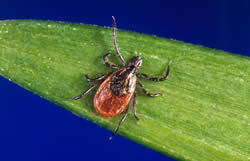Grant to fund study of Lyme disease
An East Carolina University scientist is looking at ways to treat or prevent Lyme disease with funding from a federal grant.
Dr. Md Motaleb, an assistant professor of microbiology and immunology at the Brody School of Medicine at ECU, has received a five-year, $1.8 million grant from the National Institutes of Health to study the tick-borne disease.

Dr. Md Motaleb is studying the bacteria that causes Lyme disease with help from an NIH grant. Photo by Doug Boyd
Specifically, Motaleb is studying the bacteria Borrelia burgdorferi, the agent that causes Lyme disease, to determine exactly how the germ moves through tissue, reaches its destination and causes infection. Information about that process could help lead to measures to treat the infection or prevent the bacteria from ever reaching its destination in the first place, such as a vaccine, he said.
Lyme disease is spread by deer ticks and is the most common tick-borne disease in the Northern Hemisphere. The number of Lyme disease cases reported to the federal Centers for Disease Control and Prevention increased 300 percent between 1997 and 2009, from 12,801 cases to 38,468 confirmed and probable cases.
Typical symptoms include flu-like symptoms such as fever, headache, fatigue, myalgias and a characteristic skin rash called erythema migrans, according to the CDC. Most cases of Lyme disease can be treated successfully with a few weeks of antibiotics. If left untreated, infection can spread to joints, the heart and the nervous system causing Lyme arthritis and cardiac and neurological abnormalities. Although very rare, deaths have been attributed to Lyme disease.
The grant funds pay for salaries for laboratory personnel and reagents to perform the research. A part of this project will be performed at University of Toledo in Ohio.
Motaleb has published four scientific articles this year on Borrelia burgdorferi and has studied the bacteria for more than 10 years.
In addition to this grant, he is co-investigator on an NIH grant with a professor at the University of Texas Medical School at Houston.

Ixodes scapularis, or deer tick. Actual size is 2-4 mm. Image from Centers for Disease Control and Prevention website

Borrelia burgdorferi, the causative agent of Lyme disease. The parasite resides in ticks and mammals. Actual size is 10-20 micrometer. Image courtesy Dr. Md Motaleb